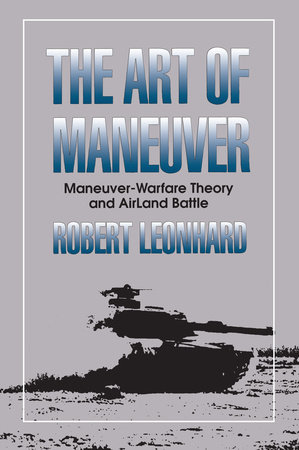Excerpt
The Art of Maneuver
CHAPTER 1
FRAMEWORK FOR MANEUVER
The best strategy is always to be very strong.
—Clausewitz, On War
INTRODUCTION: THE FLOWERY WARS
The ancient Aztecs worshiped, among others, Huitzicoatl, the storm god. One of the most important aspects of their worship was to provide Huitzicoatl with his favorite nectar—human blood. In order to satisfy the god’s grisly thirst, the Aztecs employed a ritualistic method of fighting other tribes known as “the flowery wars.”1 The purpose behind the flowery wars was not simply defeat of the enemy per se; the Aztecs were motivated to glorify and focus upon the bloodshed that resulted from battle. If possible the enemy was not killed outright but rather captured, so that later his heart could be ritually cut out and offered to Huitzicoatl. And since all participants basically worshiped the same gods and viewed the flowery wars from the same perspective, there was a sort of cooperation, rather than competition, associated with the fighting. Once challenge had been officially offered, both sides’ priests would meet to arrange for battle on the most auspicious day. Each side was meticulous about giving the enemy the best opportunity to prepare for the battle. It was unthinkable to concentrate instead upon defeating the enemy, imposing one’s will through force of arms, and ending the fight on favorable terms at the least expense of men, materiel, and time. To win and win cheaply would have been regarded as blasphemy—selfishly withholding the proper blood sacrifice.
Thankfully, Huitzicoatl is dead—or is he? Can we perhaps detect his sanguinary presence in our army today? Can we track his bloody footprints along the halls of our training institutions? Do we hear his priests chanting as we listen to the latest versions of our fighting doctrine being preached? Whether for the sake of deities, doctrinaires, or just grand old traditions, there appears to be an immovable fixation upon attrition theory within the U.S. Army, at times approaching the madness of the Aztecs’ flowery wars in its application. The priorities found in doctrinal manuals, in schools, in combat units, and most important, in the souls of our leaders often appear to be aimed at destroying rather than defeating, at fighting fairly rather than stealing every possible advantage over the enemy, and at pursuing perfection in method rather than obtaining decisive results. Virtually every effort—whether designing new vehicles, improving weapons or munitions, developing new tactical concepts, or training officers—seems bent on fighting toe-to-toe with a prepared enemy, leaning into his strength, and outlasting him rather than outthinking him.
This book is aimed at investigating these trends: defining them, exposing their weaknesses, and breaking the cognitive logjam that threatens to block creative approaches to developing effective fighting doctrine. There is a wealth of innovation and energy within our combat-arms leaders that will never be channeled effectively under the constraints imposed by our current doctrine and institutionalized inertia. This study is designed to offer some new thoughts and to inject new directions in our doctrinal developments. To accomplish this task in a way that is at once accurate, inspiring, interesting (even entertaining), and—most of all—useful to friends and foes of the concept alike, I have attempted to define the term “maneuver warfare,” compare it to its theoretical antithesis (attrition theory), and then evaluate our current and evolving doctrine in the light of maneuver theory.
THE CHALLENGE TO DEFINE
When Antoine-Henri Jomini wrote his Art of War, he came under attack by his contemporaries for his presumptuous dogmatism. His attempts to provide concrete and useful definitions and concepts of military theory enraged many of his peers. In reply he wrote:
I hope … I could not be accused of wishing to make this art a mechanical routine, nor of pretending on the contrary that the reading of a single chapter of principles is able to give, all at once, the talent of conducting an army. In all the arts, as in all the situations of life, knowledge and skill are two altogether different things, and if one often succeed through skill alone, it is never but the union of the two that constitutes a superior man and assures complete success.
It seems that throughout all walks of life, and particularly within the military profession, there persists a dislike, even a fear, of definitions. Whether because a clear definition of a term or concept immediately begs questions about the exception, or because Western man’s love of pluralism causes him to be wary of dogma, one finds that to define a military term is to create an argument. Within the U.S. Army there seems to be a recurring trend first to organize, categorize, and lend specificity to the field manuals and other publications that articulate our doctrine, and then to retreat from such assertions in the name of encouraging innovative thinking. I recall the sense of frustration I had as a young infantry lieutenant, hungry for knowledge but unable to find anything substantial in my “how-to-fight” field manuals beyond vague generalities and buzzwords that left me unprepared for the complexities of mechanized operations. Then again, as a captain I was pleased to find revised manuals that offered well-organized, specific tactical procedures for small units. I have observed the cycle continue ever since: an attempt to articulate specific and useful ideas followed by a cautious retreat into vagueness.
But without some established definitions and principles, a journey into military theory is impossible. Therefore, this chapter is devoted to defining terms and concepts to be used throughout the remainder of the book. We shall progress in the course of four chapters to the objective of specifying from the perspective of both military history and modern theory what the term “maneuver warfare” means and what it doesn’t mean. It is necessary to prepare for our examination of the subject by first establishing a framework for discussion. I have drawn upon many sources for this chapter, and in some instances I will suggest some new ideas.




